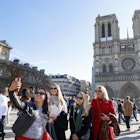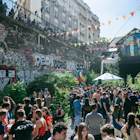
Nov 6, 2024 • 7 min read

Mar 3, 2023 • 4 min read

Down a hard-to-find stairway, the newly renovated art nouveau Lavatory Madeleine astonishes © Michiel Stock / courtesy Lavatory Madeleine
There are public toilets, and then there’s the Lavatory Madeleine in Paris, an art nouveau beauty that’s just reopened after a stunning renovation.
As a steady stream of visitors winds their way down the spiral staircase and into the underground public toilets, a gentleman emerges from behind the urinals and wipes his hands vigorously with paper towels.
“How was it, Monsieur?” the bathroom attendant asks cheerfully, in French.
“It’s like taking a wee and visiting a museum at the same time,” the man quips.
This is a clever and accurate description of Paris’ newest and arguably most novel attraction: the Lavatory Madeleine, which easily claims the title of the most beautiful public facilities in Paris – and maybe the world.
The creators of this facility, designed in the art nouveau style and opened in 1905, spared no expense. Yet years of disuse and disrepair led to its closure in 2011, the same year its its Belle Époque design earned it a designation as a historic monument.

Following a lengthy restoration project, this stunning architectural gem located beneath the Place Madeleine has reopened to the public. Dark mahogany wood doors gleam from fresh coats of varnish, while repeating rows of stained glass windows and ceramic mosaic tiles are embellished with sinuous floral motifs that evoke a bygone era.
“You’re traveling to the past,” said Fabrice Larbaletrier, director of operations at 2theloo, specialists in public restrooms who collaborated with the city on the project. “You enter the toilets, and you feel like you’re back in 1905.”
But entering this time warp, as Larbaletrier describes, requires finding the toilets in the first place.
After circling the entire perimeter of La Madeleine church, I finally stumbled on the entrance across from the Decathlon sports store. It’s easy to miss, as the entrance could be mistaken for one of the area’s several underground parking entrances, and there are no conspicuous signposts to point the way.

But it’s precisely this modest, inconspicuous entrance that makes the descent feel like a secret passage – an unexpected surprise reserved exclusively for those in the know.
If you really do need to use the facilities, it’ll cost you €2. There are six toilets, each with its own sink and mirror (one oversight is the lack of hooks for coats and bags) along with four urinals, and the lavatory is mixed-sex. But if nature is not a-calling, you’re invited by the enthusiastic attendants to peruse for free at your leisure.
“Come in, come in,” one of the hosts says, beckoning to the visitors hesitating at the entrance. “Make yourselves at home.”

For the French, such a welcome is a far cry from the traditional “dame pipi” (Madame Peepee), a female toilet attendant who collects entry fees and cleans the loos. (If you watched the second season of Emily in Paris, the concept will sound familiar: Mindy, played by Ashley Park, worked as a dame pipi at a drag club.)
But the decision to eliminate the position that existed in the lavatory’s previous incarnation was a deliberate one.
“Dame pipi evokes a pejorative image,” Larbaletrier said. “I’m old enough to remember the lady sitting in her stall, waiting for change, barely saying hello or goodbye. Our staff welcomes the customer, orients them, and cleans the toilets after every use. It’s not the same job at all.”
Indeed, as we visitors gawk, gaze, admire and take photos, the attendant provides enthusiastic commentary.
“This is all original, Madame,” he says, pointing proudly to the pipes behind the toilets. “They didn’t change anything.”

Another feature not to be missed is the loo’s original shoeshine chair. While there’s no one offering this service to customers – yet – Larbaletrier says that could change, pending demand.
Unfortunately, because the toilets are underground and classified as a historic monument, they are not accessible or wheelchair-friendly. Which begs the question: why were they built underground in the first place?
Because it would have been in poor taste to build a standing public toilet next to a church, Larbaletrier says.
It’s the same reason why the public toilets next to the Notre-Dame Cathedral – currently in operation but not widely publicized because of the church’s closure – are also underground.

For those times when the urge strikes and art nouveau architecture is the least of your concerns, look out for one of the 435 public restrooms on the streets of Paris called Sanisettes: self-contained, self-cleaning units that are free to use. Combined with public urinals, Paris boasts 750 public potties in the city – which gives the city the claim to the most public toilets per square kilometer around the world.
In preparation for the Paris 2024 Olympic Games next year, the Sanisettes will be replaced with a new fleet of next-generation toilets that will be water- and energy-efficient, and pull double duty with the addition of a separate urinal cabin. The number of wheelchair-accessible units will double, and outdoor hand-washing stations will be installed. Existing toilets will be recycled and put back into service in other parts of France or abroad.
All of which is to say, when nature calls, Paris has you covered.
The Lavatory Madeleine is located near the southeast corner of the church and is open every day from 10am to 6pm. Entry is €2. You can find your nearest public toilet in Paris using this online tool.

Architecture
A Total Trip: what I spent on dining, drinks and museums during a weekend in ParisJul 27, 2023 • 4 min read

Nov 6, 2024 • 7 min read

Oct 31, 2024 • 11 min read

Oct 31, 2024 • 5 min read

Oct 24, 2024 • 13 min read




Aug 23, 2024 • 8 min read
